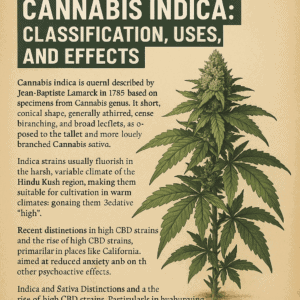 Exploring Cannabis Indica: Classification, Uses, and Effects
Exploring Cannabis Indica: Classification, Uses, and Effects
Cannabis indica is an annual plant in the Cannabaceae family and is a debated type of the Cannabis genus. The classification of Cannabis indica and Cannabis sativa as separate species is contentious. Indica is known for its utility in textiles due to its fibrous nature and is high in tetrahydrocannabinol (THC), which contributes to its euphoric effects, making it popular for both recreational and medicinal use.
The plant was first described by Jean-Baptiste Lamarck in 1785 based on specimens from India. Botanically, Cannabis indica is characterized by its short, conical shape, dense branching, and broad leaflets, as opposed to the taller and more loosely branched Cannabis sativa with narrow leaflets.
Indica strains usually flourish in the harsh, variable climate of the Hindu Kush region, making them suitable for cultivation in warm climates due to their robust nature. These plants are typically cultivated in the Indian subcontinent to produce charas, a type of hashish. Pharmacologically, indica strains generally have higher THC content compared to sativa strains and are reported to produce a more sedative “stoned” effect versus the uplifting “high” associated with sativa.
Indica and Sativa Distinctions and the Rise of High CBD Strains
Indica’s effects are often described as a “body buzz,” providing pain relief and benefits for conditions like insomnia and anxiety. Popular indica strains include Kush and Northern Lights. In contrast, sativa is known for more cerebral effects, which may include creativity and energy.
Recent genetic studies have grouped both narrow-leaflet and wide-leaflet drug biotypes under Cannabis indica, alongside various hemp landraces and wild populations from Southern and Eastern Asia. The distinction between indica and sativa includes differences in plant morphology, bud structure, and effects upon consumption.
In recent times, there has been a growing trend towards breeding Cannabis strains with higher CBD to THC ratios, particularly in places like California, driven by medical demand. These strains are less likely to produce anxiety and have a reduced psychoactive effect due to the higher CBD content. This shift reflects a broader interest in the medicinal potential of Cannabis, particularly for treatments requiring higher CBD ratios.